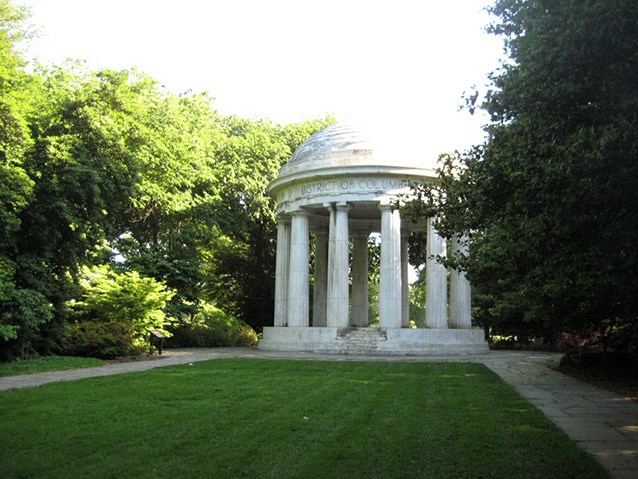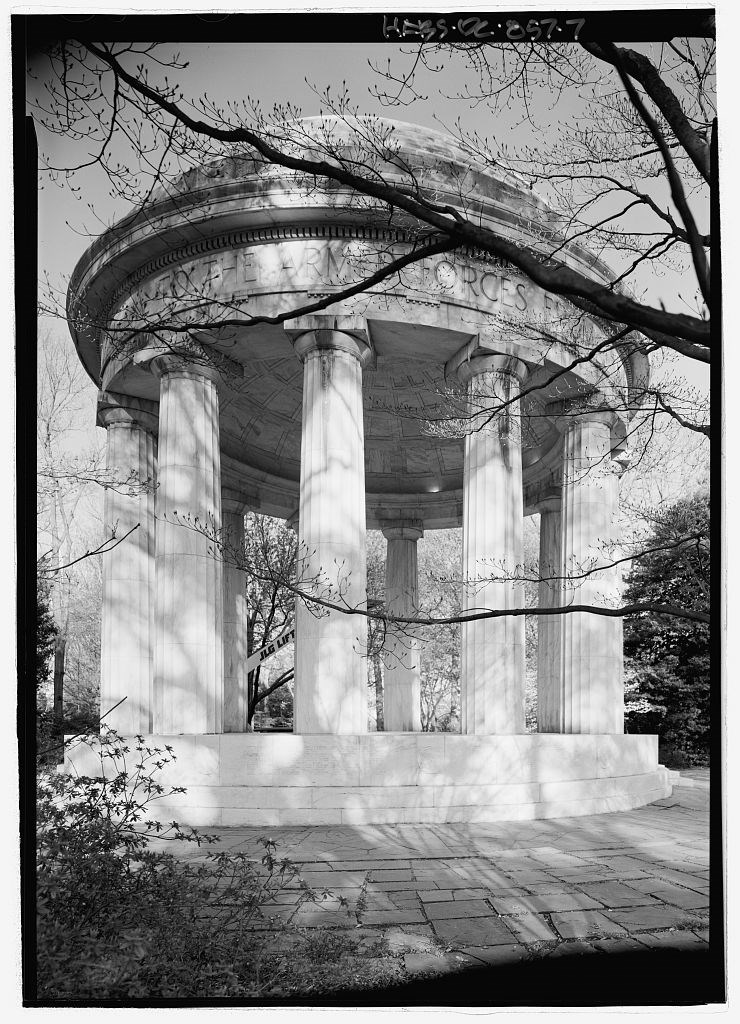Last updated: October 8, 2021
Article
DC War Memorial Cultural Landscape

NPS
The Washington DC War Memorial cultural landscape, a historic designed landscape of the National Mall, is managed by the National Mall and Memorial Parks (NAMA). The Washington DC War Memorial is part of West Potomac Park and is located south of the Lincoln Memorial Reflecting Pool and north of Independence Avenue SW. Like other memorials of the National Mall, the space associated with the Washington DC War Memorial was first delineated by the McMillan Plan of 1902. The DC War Memorial has a national level of significance. The period of significance is from 1931 to 1939, encompassing the initial construction and realization of the planting design.
The 2-acre cultural landscape is an approximately 350 ft-diameter circle, with a north-south axis of turf panels enveloped by a deciduous tree grove. At the midpoint of the circle and midway along the turf axis, is a circular marble tempietto, or a small, classical Greek temple-like structure. The tempietto design consists of a circular plinth supporting 12 Doric columns which support a domed roof. The form of the structure is in keeping with the simple geometric vocabulary of the structures of the nearby memorials. The white marble was quarried in Danby, Vermont and the design is credited to architect Frederick H. Brooke in 1919.

HABS, Library of Congress
The tempietto and turf panels are framed by limestone paving. The flagstone encompasses the tempietto in a circle walkway, and runs parallel to the turf panels, reaching north towards the Reflecting Pool, and south to Independence Avenue. The flagstone material was salvaged from the site of the U.S. Treasury Building. The planting plan for the DC War Memorial was originally developed by the landscape architect C. E. Howard in 1915, as a part of the design of the Lincoln Memorial.
The deciduous tree grove consists of oaks, beeches, and elms. These were designed in a naturalistic pattern that differs to the formal arrangement of elms at nearby memorials. The bold contrast between the smooth marble of the tempietto and the wildness of the grove, was integral to the design intent of classical Greek elegance. The grove was planted by the National Capital Chapter of the Garden Club of America. American elms, which were the most widely planted species, were affected by Dutch Elm Disease and have since been removed. During the 1940s, the National Park Service refined views of the tempietto by removing trees that obscured the central axis, and thinned the canopies of remaining trees.
At the conclusion of World War I, Potomac Park was a place for playing polo. A wooden bandstand stood on its east end, with a grove of willow trees to the west, where the War Memorial would later be built. The House of Representatives approved the Commission of the War Memorial in June 1924, requiring that the structure be of a design suitable for musical performances, replacing the wooden band stand. The memorial structure and surrounding landscape would host concerts for the public.
Dedicated on Armistice Day, November 11, 1931, the District of Columbia War Memorial stands as a monument to Washington, DC residents who served during the First World War. Following the end of the war on November 11, 1918, many residents of the District wrote letters expressing a desire for memorials to recognize the service of local veterans. While the memorial has not been used for musical performances since the 1960s, it remains a place for passive recreation, proposals of marriage, and special memories. Today the memorial continues to honor more than 26,000 Washingtonians who served in World War I.
Quick Facts
- Cultural Landscape Type: Designed
- National Register Significance Level: National
- National Register Significance Criteria: A
- Period of Significance: 1931-1939
